Irish Diary, October 2000
Celtic Women in Music
The making of a documentary film in Ireland
Notes and observations on our very special trip to Ireland
by Maireid Sullivan
Photographs by Ben Kettlewell and Maireid Sullivan
Click here for short film clips from the interviews.
Great Stone Circle of Grange 'visionary insights' shared HERE
Producer & Interviewer: Maireid Sullivan
Cinematographer: Joe Edwards
Sound Engineer: Ben Kettlewell
Excerpt: Ireland did not think of today's corporate investors in terms of predatory occupation when multinational companies were invited into the country, during the 80s and 90s, to assist with the building of corporate power and wealth, much like the Normans and the English of old were invited. While there is an awareness that a new, superficial 'ascendancy' has arrived, there is little realization that the country has been occupied. Contemporary literature does not show signs that something tragic has happened, because traditionally the Irish have never regarded Ireland as being permanently occupied.
Index
- Introduction
- Diary: Home again
- Interviews
 INTRODUCTION: INTRODUCTION:
After a quick visit to my own home area, in West Cork, Ben and I set out to film conversations with fourteen of Ireland's most celebrated women musicians, representing a cross-section of many styles of Irish music. Full transcriptions of in-depth interviews with thirty of over seventy Celtic women musicians, from all over the Celtic world, can be read in my book, "Celtic Women in Music" Vol.1, published by Quarry Music Books in 1999. Vol. 2. has yet to be published.
Music can bring great comfort when we feel wrapped in the warmth, intelligence and skill of talented artists. Each time our attention is captured by good musicians we make new discoveries about the spirit of humanity, in the poetry of their songs and in their new combinations of rhythms and melodies.
These gifted women present us with an intimate experience of the inner workings of Celtic culture, especially in Ireland. Deep enjoyment of music is a gift that can be developed, both for the musician and for the listener. The listener's appreciation is the response that creates a renewal of the original spring of the music. Through all time, the power of music to move hearts and draw people together remains a mystery.
When life became 'hard' in Ireland, long ago, it is a miracle that affection, laughter, music and dance survived at all. Not only has this unique quality of joy survived, it is thriving! It is a testament to irrepressible enthusiasm that joy expresses itself involuntarily in a burst of song, and in the body's response in dance.
 I think today's Irish artists are like the Fenian heroes of old who upheld the freedom of the country. They were loved by all and were free of all tribal retributions. A Fenian hero had to know the poet's repertoire, and submit to initiatory tests of skill and courage to withstand great trials. Their ranks were made up of druids, brehons, physicians, musicians, poets, and warriors - united in their commitment to honor and protect their cultural heritage. I think today's Irish artists are like the Fenian heroes of old who upheld the freedom of the country. They were loved by all and were free of all tribal retributions. A Fenian hero had to know the poet's repertoire, and submit to initiatory tests of skill and courage to withstand great trials. Their ranks were made up of druids, brehons, physicians, musicians, poets, and warriors - united in their commitment to honor and protect their cultural heritage.
They were the source of inspiration for the leaders of the Irish revolutionary movement at the beginning of the 20th century.
New-found prosperity has led to major changes in all aspects of Irish life. Ireland, the Celtic Tiger, is not as green as it used to be, politically or economically as well as environmentally. While there is a tremendous renewal and excitement everywhere, over the possibilities of prosperity, the speed of change is not seen to benefit all the people. According to The Irish Times' journalist, Mary Cummins, modern Ireland is a society created largely by and for men. Her column About Women "has surprised, provoked and infuriated readers, and stimulated discussion of many aspects of Irish life". Ms Cummins, having returned to Ireland after several years in England, has the view that old-fashioned chauvinism is still thoroughly ingrained amongst Irish men, particularly in politics. And, she believes the increased numbers of women in public office are there only because it suits the political agenda of the men in office.
This scenario does not necessarily apply just to Ireland. Anyone would agree, there is a need for greater imagination, wisdom and knowledge, freedom and courage in media interpretations of the complexities of major social change. Like works of art, new perspectives await unveiling by original insight.
There can be no doubt that we are witnessing an exciting time for women in all spheres of public life, in Ireland, and all over the world. We are entering a new era that must acknowledge women's equal rights in order to draw upon their abilities. These positive new developments inspire a grassroots renewal of celebration, as well as the energy to get on with the job of maintaining sustainable life on the planet, while correcting long-established injustices.
As strong and compassionate women enter the scene, the flame of their commitment will inspire the energy needed to support courageous and nurturing work both by and for men and women everywhere. We readily refer to the 'global brain' in this communication age. I believe the emergance of women in public life will strengthen the global heart of compassion. Compassion need not be submerged, under the "glass ceiling".
More than ever it is important that strong-willed, 'big-hearted' people become active in all aspects of public life: to bend the new shell to their liking; to popularize the free expression of their personalities, to laugh, to sing, to dance with joy, as well as to voice their concerns and express their sense of social responsibility; and to seize an opportunity to affirm the multifaceted, positive nature of humanity.
Since the exhilarating Mary Robinson became President of Ireland, in 1990, I have come to be very impressed with a succession of brilliant Irish women leaders, both in politics and in the arts: Irish women politicians don't seem to be as much concerned with being "iron ladies'" as with being effective and just legislators.
Irish women musicians don't seem to be as concerned with the status of their roles as with expressing their wellspring of wisdom, which still flows from their ageless heritage, in their music and poetry.
My mother observed that many young people have lost their conversational spontaneity because they are being educated by corporations rather than by poets.
The Irish have a historical cultural precedent, unique amongst Europeans, in the Brehon Laws, which served to maintain the equal rights, two halves of a whole, of Irish men and women until the 17th century. This precedent should serve to enlighten and guide us as we move toward achieving a more equitable balance in public and private life. A unity of social consciousness, shared by men and women, is urgently needed to insulate and protect the people from potentially detrimental effects of the rapidly expanding corporate private sector's purely profit agenda. The combined skills of men and women are needed now, more than ever, to strengthen public sector agendas--solutions to the needs of all of the people toward preventing social and financial inequalities from widening amidst unsustainable specualtive development.
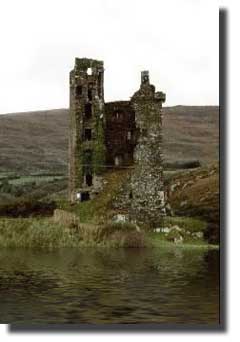
Ireland did not think of today's corporate investors in terms of predatory occupation when multinational companies were invited into the country, during the 80s and 90s, to assist with the building of corporate power and wealth, much like the Normans and the English of old were invited. While there is an awareness that a new, superficial 'ascendancy' has arrived, there is little realization that the country has been occupied. Contemporary literature does not show signs that something tragic has happened, because traditionally the Irish have never regarded Ireland as being permanently occupied.
The spirit of independence is so deeply rooted in the Irish character that the Irish people will withstand the thrust of corporate globalization. Modern corporate entities will experience an incomplete conquest of the Irish people, particularly over the Gaelic/Irish-speaking population, whose ancient language sustains their commitment to the unique expression of their thinking. Newcomers will soon become charmed by the Irish way of seeing the world. They will adapt to the Irish way of life, directly due to the ability of the Irish to absorb foreign ways.
Dublin has been the center of colonial power in Ireland for over a thousand years, but its exercise of that power was not seen as relevant or even benefiting to the needs of the rest of the population. The surprising twist is that Dublin is now being referred to as the "Super Gaeltacht", meaning it has the largest population of Irish speaking people, as well as Irish speaking schools, in the country. The Dublin Institute of Advanced Studies is a leader in translating documents from the old Irish culture, particularly on the Brehon laws.
At the very time that Ireland is seriously acknowledging its unique past, it is undergoing infrastructural modernization. It is hoped that Ireland's new bond with Europe will strengthen
its sense of independence amongst a network of similarly independent nations.
There is evidence that the whole world could enter a new golden age, with unprecedented accountability and responsibility, via the Information and Communication Ages.
The world famous photograph of the Earth taken in 1972 by the Apollo 16 astronauts as they flew back from the moon shows our planet bathed in light. It is not like a human map, in which lines mark the boundaries of our territoriality. It shows the earth as a seamless, borderless biosphere where winds and waters, currents and streams, like the flow of people and their ideas, weave around a ball that is gliding through space, "hued in the sun. The tilt, lilt, lull of the mind's eye" (Soaring, 1993), in our galaxy, one amongst billions.
Diary: Home again
back to top
I'm not sure how global warming will affect Ireland. The Irish have enjoyed wonderful summers in recent years, but the rain was predictably steady during our drive south along the coast from Dublin, on Monday, the 9th of October. My brother Daniel, who lives in Cork, was away, so Ben and I visited our friends, Gerard and Siobhan, at their home in Cork City. We thoroughly enjoyed a sumptuous supper, great wine, and the excitement of meeting again.
Over breakfast, I watched the school children playing in the school yard next door, across the garden. I was taken by an unexpected quality in the close physical contact between the children. They seemed to constantly be touching each other; jumping around in each other's arms, falling over each other, playing tag, yelling and laughing at the top of their voices. After so many years spent living amongst densely multicultural populations in Australia and the USA, in much drier climates where the physical space seems so vast, I was suddenly reminded that the moist air makes everything seem so much closer, more magnified, in Ireland. The need for "personal space" is not an issue in Ireland. I wonder whether the narrow vibrato, characteristic of the Irish singing voice, may also have developed because of this close atmosphere. On the other extreme, mountain people generally have a wide vibrato, which could have developed from the echoing of sound over a much more open, less dense atmosphere.
We couldn't help but notice the many new immigrants steadily arriving in Ireland from all over the world, along with many Irish returning to live, mostly from Australia and the USA. It is worth remembering that Ireland, at the longest and widest points, is three hundred miles long and two hundred miles wide, and has a total population, North and South, of less than six million people.
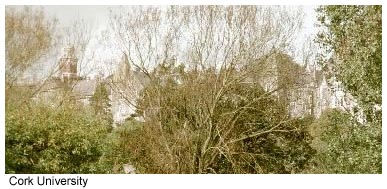
We continued on our journey late in the morning, skirting the city center, passing magnificent University College Cork, through lovely autumnal countryside, on our way to West Cork.
We stopped for lunch in the town of Dunmanway. We were directed to the Shamrock Pub, where we would find good, old-fashioned wholesome food and a great welcome from the people there.
This is a well-beaten track to West Cork, but the people we met when asking directions on the street, then at the pub, seem not to be overwhelmed by strangers. There again, the concept of 'keeping to themselves' does not seem to apply.
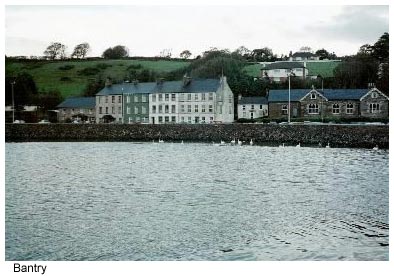
We arrived in Bantry from the south end of the town late in the day. We came upon Bantry House and the Bantry graveyard, where my father and his family are buried. I was pleased to see that Bantry looked very prosperous and still retained its beautiful Old World appearance and charm. We had dinner in Clarets, a very good restaurant in town.

It was dark by the time we drove out to the old pub in Pearson's Bridge, which has new owners. We took John Manning, pub patron, by surprise. John is the son of Eileen Keane, one of two sisters who lived just up the road from us when we were children at Pearson's Bridge. His aunt, Kathy Keane now lives in New York City. There were about eight relatively young men and women coming and going in the small bar.
One of them, a twenty-three year old good-looking fellow, whose name I don't want to remember, was very drunk. His eyes were unusual. I had a sudden insight that this young man could be a poet, and I asked him if he was a writer. He asked why I thought that. Acting on my seniority as a woman, I told him that his eyes had great strength and that he could achieve great things if he didn't become a victim of the drink.
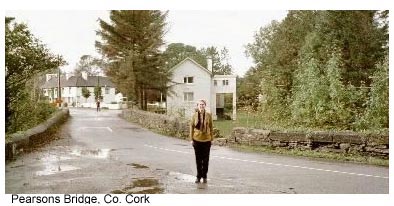
The 'craic was ninety' by the time we decided to go. I should mention that my mother had a big laugh when I told her later that before we left, John Manning commented that I had taken over the room in twenty minutes, while some people couldn't get a hearing in twenty years.
In Ballylickey, we had lunch with my second cousin, on my father's side, Pat O'Sullivan, the veterinarian, who, naturally, knows nearly everyone in the whole area. He brought tears to my eyes with stories of the heroic deeds of his father and mine, who were great friends all of their lives. He gave me a wonderful little book, just published, "It Might Have Been But Yesterday:
A Bantry Anthology".
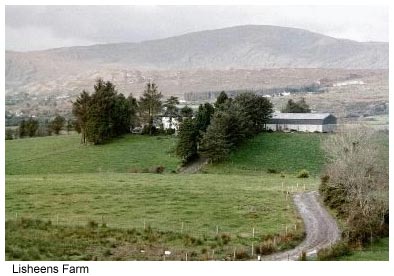 The main purpose of this quick trip back to West Cork was to show Ben where I grew up. I particularly wanted him to see my mother's family farm, at Lisheens. We drove up the hill, all the way to the top. Across the wide yard, a young woman approached us. I was a little embarrassed to just roll up, unannounced, but we were greeted with a warm welcome by Rose McSweeney. The main purpose of this quick trip back to West Cork was to show Ben where I grew up. I particularly wanted him to see my mother's family farm, at Lisheens. We drove up the hill, all the way to the top. Across the wide yard, a young woman approached us. I was a little embarrassed to just roll up, unannounced, but we were greeted with a warm welcome by Rose McSweeney.
Looking into Rose McSweeney's lovely young face, I was entranced by her beauty and freshness. I noticed how much her freshness resembled my mother's, particularly as she must have looked at the same age, before she married at the age of twenty-seven and bore seven children, all within eight years. This healthy environment would be a major source of my mother's continuing good health and vitality.
Rose wouldn't shake hands, because, she explained, she had just been working with the cows when we arrived and hadn't had a chance to wash her hands. She called her father out and he welcomed us with a strong handshake. He bought the farm from my parents, when we moved down the hill to Pearson's Bridge (because my father, who was an equestrian horse trainer at that time, was away in America more than he was at home and couldn't care for the land).
I experienced a tremendous sense of gratitude for my wonderful childhood in this place, within a large family, including my grandmother, Bridget, a nurse, whom we called Tata, and my great aunt Jane, a retired dietitian, both of whom lived with us and helped care for us with great skill and love. My grandfather, Jeremiah Hurley died before I was born.
back to top
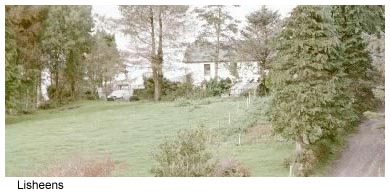 The farm looks very prosperous. The farm looks very prosperous.
The house is surrounded by a carefully maintained garden, with plants in pots at the front. I feel so happy to know that the farm has continued to thrive in such good hands. It looked almost exactly as I remembered it, with the addition of two large barns on the side and a kitchen extension, built in with the old style. Rose showed us the beautiful stained glass windows that had been there when they bought the house. Ben took photos of the house and garden, with her permission. They told us that we could drive up the back road, through the middle of the farm, to see the ring fort. ("Lisheens" is the Anglicization of the Irish word for stone circle.) They opened the first gate and we drove through the watery mud.
The rain had stopped pouring down just half an hour earlier. We drove on up the steep hill, thinking we might surely slide down again on the slippery mud. But we made it to the top and there we found an old slate mine, with slate and stones strewn everywhere. We were able to walk across the slate to the next paddock where the grass was thicker and less saturated.
We climbed up over the ancient stones of the ring fort which were well covered over with moss. We went in to the middle of the ring to behold a panoramic view of the whole country around us. The clouds lifted and the warming rays of the sun shone through. We could clearly see the beautiful valleys below, the rolling hills and Bantry Bay in the distance.
These are the hills I view 'in my mind's eye' wherever I am in the world.
back to top
We drove down to the local graveyard, Killmacmogue, where my mother's ancestors are buried, very near the bottom of her family's farm. We walked along the path through the open field behind the graveyard to see Lady's Well, which is almost hidden from view.
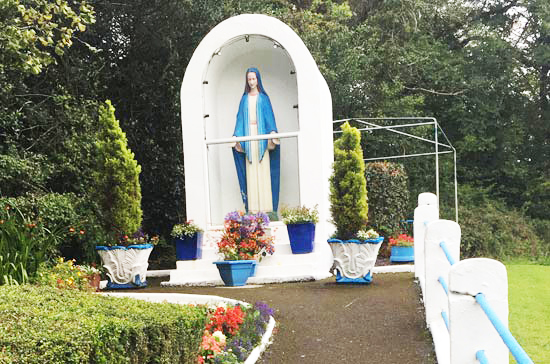
My father, John "Jack" (O')Sullivan built this shrine above Lady's Well, (including the surrounding walls), near Kealkill, West Cork.
In late 1951, our mother, pregnant with our sister, Noreen (Hanora Bridget), was rushed to hospital in Cork City with a serious infection.
The entire community gathered at Lady's Well to pray for her.
Following her full recovery and Noreen's birth in May 1952, our father expressed his gratitude by building this shrine, with the help of our mother's brother, uncle Denis Hurley, of Lisheens, and our uncle Michael "Mick" O'Sullivan, of Lackareagh, Kealkill, with the support and encouragement of local friends.

Long years have gone into shaping the kneeling stones and steps that surround this very old and beautiful grotto, which likely was a sacred site in pre-Christian times.
I remember playing with my brothers and sisters on the grassy hillside and picking bluebells and daisies while my mother stopped to pray, first at the grave of her parents and then at the Holy Well, on the way home from Church in Kealkill nearly every Sunday.
Large and small statues of Mary have been placed there by several generations of families from the surrounding area. Intricate arrangements of perpetual lights from oil lamps, candles, flowers, medals, tiny framed holy pictures, and rosary beads, surround many of the statues. Most of the statues are housed in arched blue or white boxes, set into the hillside on three levels over a pool of 'holy' spring water. There is an iron kneeling rail at the front of the pool, and the bubbling creek flows right next to it. A large tree trunk, growing across the grotto, holds rosary beads, medals and miniature statues of Mary, Jesus and saints.
The 15th of August is the feast of the Assumption of Mary, body and soul into heaven. Every year, the grotto is repainted, decorated with flowers, welcoming the large crowds of locals who gather to keep a three day vigil of prayer, and candle lit for whose who come at night, for "more, undistracted prayer" according to my mother. There is a great sense of quiet in this place. The joy of prayerful thought comes easily. As I lifted my eyes from this beautiful grotto to look out over the lush green fields before me, I felt the calmness that comes from a sense of 'super-conscious' familiarity. Nothing else mattered. This was the climax of my visit 'home'. I felt very happy to share the 'homeland' of my dreams with Ben; in the middle of the ring fort overlooking the beautiful place where I was born, and especially, at Lady's Well, where my mother demonstrated her art of stillness and grace.
The Interviews
Full Moon, Friday, 13th October 2000
back to top
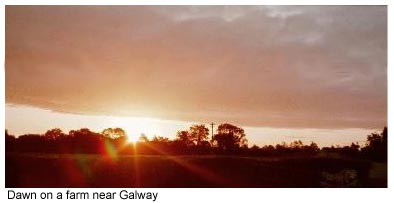
Was it auspicious that our filming began on Friday the 13th, on a day of a full moon? The moon seemed astonishingly large, nearly full, in the dark, predawn sky over Dublin at 5:30 am on Friday morning, October 13. We watched the sun rise as we headed west, on our way to Spiddal, Co. Galway, to visit Ireland's most celebrated tin-whistle player, Mary Bergin, Irish Artist of the Year, 2000.
Mary Bergin's group, DORDAN, (Irish for drone or hum) includes Kathleen Loughnane on harp, Dearbhill Standun on violin and Martina Goggin on drum and voice.
We met up with Martina Goggin, who also fills the role of group manager. She led us up over a very long narrow road through the vast headlands, where Dearbhill's family has made their home over the past five years. Surrounding the main house, overlooking breathtaking views of Galway Bay, bogs and lakes and distant forests, are several old thatched cottages in various stages of restoration for use as music workshops etc. We were invited into one of the fully and beautifully restored cottages, where a great turf fire was blazing away and tea was on the table waiting for us.
The stage was set: The women played their beautiful music and sang for us in front of the fire, all of which was filmed. Then we recorded the women having a terrific group discussion on their personal histories, praising the music they play, both classical and traditional, and revealing how their lives are wrapped up in it all. Mary believes it is a tragedy that many women give up playing music when their children come along.
Joe, our cinematographer, spent quite a bit of time filming the exotic environment around the cottages and in the distance. Ben recorded the ambient sounds, while I sat gazing into the fire.
I hadn't seen a turf fire for a long time.
back to top
After a perfect day there, we went on our way to enjoy a late afternoon meal in a quaint little pub in Spiddal. The sign over the bar said "Irish spoken. English understood". This is a Gaelic/Irish speaking area of Galway, part of the famous Connemara Gaeltacht. Many years ago, in the late 70's, I 'endured' a two-month retreat in a small monastery in Spiddal. I wore the dark blue robes, worked in the fields and with the fishing tackle. It was a severe lifestyle. The worst part if it was having to get up from our beds at night, every two hours, to walk in a circle chanting prayers, as it was considered unwise to sleep too deeply. (I certainly don't agree now.) Every day, we took turns reading books out loud, on the lives of the saints, as we tried to emulate their commitment. During that time I discovered one of my favorite songs, Sile Ni Eire, which I still like to sing unaccompanied in the ornamented sean nos singing style of that area.
That evening the sky was surprisingly clear as we watched the full moon rise high over Galway Bay. What a picture! We then headed out to see Mary Custy play her fiddle at the famous Galway music venue, The Roshin Dubh. Mary has her own band, The Mary Custy Band, but on this occasion we filmed her playing with another group, Bushplant, whom she plays with there on a monthly basis. The bandleader, Gerry Molloy, is a singer/songwriter who looks like a wizard on stage. It is a very loud band, so I couldn't hear all of his lyrics but I loved his passionate delivery of the songs. I had time to talk with several of the people there, all very friendly and interesting people enjoying a great night out. One of my friends, John O'Shaughnessy, who has a recording studio in Galway, came along to meet up with me. At the end of the night, he took the whole crew to another club in Galway, a high-tech venue, The Quays. They had a loud MIDI-based four-piece band playing medleys of everything from modern songs by U2 to traditional Irish pub songs, like Kilgary Mountains.
The stage was built in four levels to resemble a large cathedral altar framed by a huge, full pipe-organ, each level had a large pulpit in which a musician performed. I've never seen anything like it! Everyone there was in great high spirits; dancing, hugging, laughing, and singing along, … very different from the more reserved Dublin crowds. It was great craic! Except... I could hardly believe my eyes, when I watched a tall beauty, all in black, walk straight up to Ben to blatantly flirt with him, side to side, while I was standing slightly behind them, in perfect view, next to the sound engineer and our friends. She was daring! He was polite. We laughed about it all night. We headed back to our B&B at about 3 am.
Over breakfast, the B&B owners, Carmel and her husband, proudly told us that we had slept in the room that Chelsea Clinton stayed in with her traveling companion, guarded by six bodyguards, earlier in the year. Framed photos and cutouts from the local paper celebrating the event were proudly displayed in the hall.
On the Saturday morning, we were meant to visit Dolores Keane, but she was ill and couldn't meet us. Instead, we headed out for the Burren, near Ennis, along the back roads and through lovely little seaside towns from Co. Galway to Co. Clare.
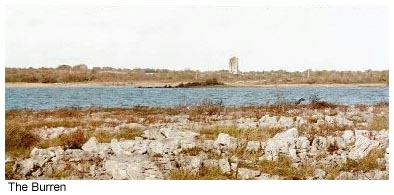
We invited Mary Custy to meet up with us, so that we could have more time to talk with her, particularly about the Burren, her favorite place in the world. She told us how the locals got together to challenge the government over development plans for the area and won!
We then went on to Ennis, which is known as Ireland's Information Technology Town. In a unique government experiment, all of the residents of Ennis within a five-mile radius of the town were given free or subsidized computer equipment and DSL online access. So everyone in Ennis now has online capability, which is something to contemplate! It seems right that Ireland should prosper in the Communication Age.
We filmed lovely moments with Siobhan Peoples while she taught her fiddle class, as part of the Ennis Comhaltas Ceoltoiri Eireann music program.
Josephine Marsh, the celebrated accordion player, met us there after Siobhan's class and together they led us up to the Drumore Nature Reserve, several miles out of Ennis.
The afternoon sun was warm, sparkling on the water, illuminating the autumn leaves. Water birds sang, glided and swooped all around us. An old raised cement walkway lined with overarching sapling trees bridged the wide, deep lake to castle ruins on the other side.
I nearly fainted when Siobhan and Josephine perched themselves on the edge of the walkway, playing their precious instruments, feet dangling and tapping over the dark water. Meanwhile, Joe, one buttock suspended over the water and the other providing ballast on terra firma, leaned his camera out to film them from an impossible angle. A bit later and less afraid, I sat on the ledge myself and interviewed them separately. It was a magical setting and they were beautiful and full of wonderful wisdom and music. When we had finished, the sun was about to set behind the trees, so we stayed on to capture the magnificent sunset on film.
 We barely had time to check into our hotel before heading off to Paddy Quinn's pub, in Ennis, to film Siobhan's regular Saturday night session. Paddy Quinn's is a small, intimate little pub and no one had ever filmed there before, so everyone was very surprised and excited by the film crew's presence. Folks of every age were there, including, to my surprise, quite a few very senior ladies. This is obviously a special place where music is the main focus. There were at least a dozen really brilliant musicians playing in the session. We barely had time to check into our hotel before heading off to Paddy Quinn's pub, in Ennis, to film Siobhan's regular Saturday night session. Paddy Quinn's is a small, intimate little pub and no one had ever filmed there before, so everyone was very surprised and excited by the film crew's presence. Folks of every age were there, including, to my surprise, quite a few very senior ladies. This is obviously a special place where music is the main focus. There were at least a dozen really brilliant musicians playing in the session.
Local historian, Sean Spellisey graciously came down to the pub to say hello personally, along with Bernie Hagger, a Kerry born enthusiast of different traditional music styles from many parts of the West of Ireland. Sean positively brims with joy and delight about life and the study of Irish history and, specifically, local Co. Clare history. He has several books published on the subject. He introduced me to Sean Reid II, son of a founder of Comhaltas Ceoltoiri Eireann. A woman gave me contact information for an artist who specializes in painting portraits of musicians. She invited us to breakfast. When I told her we were leaving early in the morning to meet Noirin Ni Riain in Tipperrary, she said, "Noirin drives the monks at the Abbey wild with her miniskirts".
I later told Noirin this and she laughed out loud at the very thought, not being able to remember how long ago she would have worn miniskirts. (Just goes to show that nearly any piece of information about a public persona can rise to become folklore.)
back to top
We were blessed in Co. Galway and Co. Clare with perfect sunshine days and clear, full moon nights, and Co. Tipperrary was just as lovely. We drove quite a distance through luxuriant countryside, passing many castle ruins, reminders of another very different Irish world, and on, through Limerick City, to see Noirin Ni Riain at her spectacular home in Tipperrary.
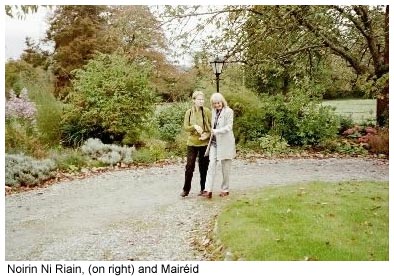 The house, which is on the historic register, is being lovingly restored to its former grandeur by Noirin and her composer husband, Micheal O'Suilleabhain. It has a grand entrance hall with a wide staircase, high ceilings, and large rooms including a warm family kitchen. There is plenty of land around the house, with two horses, two grazing donkeys, The house, which is on the historic register, is being lovingly restored to its former grandeur by Noirin and her composer husband, Micheal O'Suilleabhain. It has a grand entrance hall with a wide staircase, high ceilings, and large rooms including a warm family kitchen. There is plenty of land around the house, with two horses, two grazing donkeys,
and a Tibetan goat.
In the middle of the enclosed farmyard, surrounded by a few brown and white hens, guinea hens, a goose and a peacock, sits a huge iron cauldron from the sad time of famine era soup kitchens. I brought home some feathers.
Noirin graciously served us tea in the front room, with the help of Michael, one of her two fine tall sons. A warm fire blazed. She had set lit candles all over the room, as she likes to do when she celebrates being at home from her travels. Noirin is currently taking time off from recording and touring to complete her Ph.D. in Theology. We filmed a conversation with her in the warmth of her kitchen. She shared her insights on meeting the enthralling challenges of her current research and on the thoughts that inspire her life generally. We talked about ancient and current times in the religious life of Ireland. She told us about the ancient sites nearby and about the special 'fire' she felt when she placed her forehead against the largest stone in the Grange Ring, at Lough Gur. She advised us it would be well worth the detour to see the Grange Ring stone circle, about fifteen miles away.
See my
Great Stone Circle of Grange
'visionary insight'
report HERE |
Noirin talked about the sense of privilege she enjoys in being able to attend retreats at Glenstal Abbey. She attends daily vespers there when she is home. She thinks of the Abbey chapel as her special sanctuary, and has made several recordings with the choir of monks there.
She recommended we also go over to see it, as it's just five minutes from her home.
Glenstal Abbey is a very large castle-like structure, in perfect condition, with seemingly hundreds of acres of rich parklands attached to it. It is also a famous boys school.
As we drove in, I thought about the thousands upon thousands of men and women who took refuge in the church, many bringing great wealth with them, who dedicated their celibate lives to work for the people. We were given permission to film the external environs. The tiny gift store sold religious books, cards, rosaries, medals, icons, and Noirin's and the monks' CDs exclusively. back to top
Back on the road to Dublin
We stayed in the new Bewley's Hotel at Ballsbridge, on Merrion Road, just around the bend from Serpentine Avenue, where I lived for a year back in the late 70's. Bewley's Hotel is an amazingly ornate old building, formerly a girls boarding school, very well renovated and reasonably priced. Most surprising, the restaurant is excellent. In keeping with the old Bewley's tradition, it is an elegant place where ladies meet for tea, as well as a 'cool place' where young people can gather. There is a strong corporate clientele, which does not overshadow the atmosphere: A very rare combination in my traveling experience.
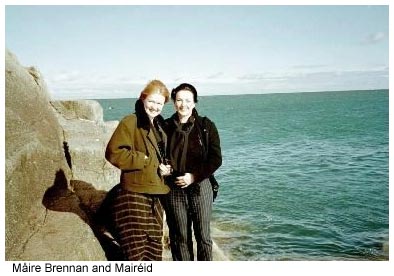 Early on Monday morning we headed off to Dun Laoghaire to visit Maire 'Moya' Brennan at her home overlooking the Irish Sea. Her home is one of those great Georgian terrace houses so popular in Dublin. three stories high, with very large rooms. Maire and her husband Tim share a very happy family life with two adorable children, daughter Aisling (Ash-leen) and son Paul. Early on Monday morning we headed off to Dun Laoghaire to visit Maire 'Moya' Brennan at her home overlooking the Irish Sea. Her home is one of those great Georgian terrace houses so popular in Dublin. three stories high, with very large rooms. Maire and her husband Tim share a very happy family life with two adorable children, daughter Aisling (Ash-leen) and son Paul.
Down in the basement, they are in the proccess of building a dark room for Tim, a photographer, and a recording studio for Maire. You can see all the signs of their long and successful careers in the wonderful collection of artifacts and furnishings displayed throughout the house. We enjoyed a cup of tea in the kitchen as Paul showed us how fast he could get around the yard on his new scooter, while the crew set up in the living room. During the interview, Maire told us about her journey as a musician, first with her Grammy award-winning group, Clannad, and now as a solo artist, pursuing her soul-searching which has brought her inner peace and a heightened sense of mission to share her love. Her music closely expresses her spirit.
 Maire took us down to her favorite nature spot, second only to her home in Donegal, she said - Sandy Cove beach at "the forty foot", where the swimmers gather every day to swim in the freezing water. I asked a group of men who were 'sun-bathing' in the freezing wind, (admittedly the sun was shining), why they like to swim in this cold wind and water and I was given several enthusiastic responses related to health and vitality. The upshot is that it is part of a great tradition and they all love it. Every New Year's Day, hundreds of people come here to swim in support of charitable causes. It's like a marathon. We filmed several swimmers, men and women, doing their long, graceful laps across the sea. The closest I ever get to that is walking barelegged through rushing cold mountain streams, preferably after heavy rains, on my irregular mountain hikes. There is nothing quite like that tingling feeling which can last for hours. Maire took us down to her favorite nature spot, second only to her home in Donegal, she said - Sandy Cove beach at "the forty foot", where the swimmers gather every day to swim in the freezing water. I asked a group of men who were 'sun-bathing' in the freezing wind, (admittedly the sun was shining), why they like to swim in this cold wind and water and I was given several enthusiastic responses related to health and vitality. The upshot is that it is part of a great tradition and they all love it. Every New Year's Day, hundreds of people come here to swim in support of charitable causes. It's like a marathon. We filmed several swimmers, men and women, doing their long, graceful laps across the sea. The closest I ever get to that is walking barelegged through rushing cold mountain streams, preferably after heavy rains, on my irregular mountain hikes. There is nothing quite like that tingling feeling which can last for hours.
After our day with Maire and her family, we headed out to Leixlip, Co. Kildare, to meet up with Eilin Loughnane, who also goes by her maiden name of Eilin Ni Bheaglaoich (Eileen Begley), during her evening Sean Nos Class at the Comhaltas Ceoltoire Eireann school. Eilin teaches Irish language at Maynooth College (University) during the week and on Monday evenings she holds a special class for young singers who come to learn her vast repertoire of the old songs. We filmed each one of the beautiful young singers as they sang a verse or two of their favorite song, followed by the whole group singing together. Eilin shared her rich memories and insights on Irish life. She grew up near Dingle, in the Kerry Gaeltacht.
Eilin described the origins of Sean Nos singing, which is basically story-telling turned to rhythmic, unaccompanied song. She illustrated this with entrancing singing to show how the old songs use the forces of nature as metaphors in expressing human emotion. She has been involved with many facets of the tradition, as an acclaimed singer and recording artist, and as a teacher of the Irish language in Ireland, as well as co-organizer, with her husband, Vincent, of Comhaltas Ceoltoire Eireann events in Melbourne, Australia.
back to top
Early on Wednesday morning we went to visit Grainne Yeats and her husband, Michael, at their home in Dalkey. Grainne has had an illustrious musical career, both as a singer and as one of Ireland's leading harpists and exponents of music for the instrument. Grainne is a truly brilliant and elegant woman. Her silver hair softly frames her face. Her blue cashmere sweater brought out the blue in her eyes. At age 75, she is stunning looking. She served tea in her kitchen, and we chatted about this and that for quite a while before the film crew arrived.
When we were ready to film, she demonstrated the extraordinarily resonant sound of her wire-strung harp, while giving us a little history lesson on the role it's played in Irish culture. She would rather not sing for us, she said, because she hadn't sung for months. But she did recite an Irish poem, and afterward explained it. She talked to us about her experiences as a touring and recording artist and about her family: her parent's extraordinary work during the lead up to and the establishment of the Irish Free State, and her children's remarkable careers. She described the ongoing reinstatement and then the renaissance of Irish culture and explained how, from the early 1950s, she worked in tandem with two very close friends on the restoration of music for the harp in Ireland. We also filmed her in the garden with her husband, Michael (the son of W.B. Yeats), before we reluctantly took our leave. I telephoned her the next day to thank her for her gracious hospitality and she told me that after we had gone her voice came back to her. I know that is a very good sign! I wish so much that I had been there to hear her beautiful soaring voice again.
We headed back to Dublin to meet Niamh Parsons (pronounced Neeve) that afternoon.
We had permission to film from the top of the Allied Irish Bank building, in the middle of Dublin. The wind was fierce, but we found a sheltered corner. We arrived well before Niamh was scheduled to appear. On the way there, Joe filmed a glimpse of the Irish President, passing in her limousine with full entourage. From the rooftop, Joe filmed Dublin's evolving city scape.
Niamh arrived, to hugs all around. Joe immediately told her that she had to stand on the ledge for dramatic effect. I think she half took him seriously for a moment! What a brilliantly generous soul Niamh is! She talked to us about her life with her darling daughter, and about her world travels as a celebrated singer of traditional songs in the English language. She even sang one of her favorite songs for us up there on the roof, as the wild wind blew around us.
From our roof-top perch, we scanned the horizon looking for interesting things to film: Among them, a steam-train puffing it's way into the city from the North and white clouds against the blue sky. Joe saw that he might be able to get a better view from the roof of the next building, which was only about three or four feet way. We had to convince him it was not a great idea to jump over with the camera. Throughout the filming expedition across the country, we noticed that Joe would do almost anything to capture a good scene. (An acclaimed film maker, Joe Edward's recent credits include filming U2 & The Chieftains.)
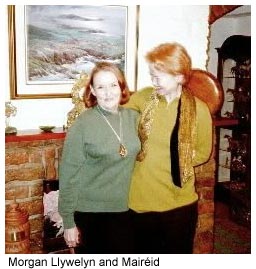
Two days later, Ben and I went on another, separate adventure, to interview Morgan Llywelyn,
the famous historical fiction writer, at her home about an hour north of Dublin. See transcript HERE
It was so interesting to hear her personal story. Morgan was born in the U.S., of Irish and Welsh parentage. She told us about her love of horses, how she came to be short-listed for the American Olympic equestrian team.
Morgan
described the devastation she experienced when she narrowly lost her chance to participate in the Olympic Games, coming in fifth in the final tryouts for four places. She knew her beloved horse could not wait for another four years. She described how her mother quickly came to her rescue, helping her avoid shattering depression by redirecting her interests to the job of researching her family history. To make a long story short, when she discovered the Llywelyn connection with Wales and the Battle of Hastings, she wanted to tell the whole family. Her mother suggested she write it all down.
She was soon encouraged to present her manuscript, unsolicited, to a publisher who happened to walk by the desk, piled with submissions, saw her name and wondered if this was the same Morgan Llywelyn of equestrian fame. The publisher immediately read the manuscript for
"The Winds of Hastings", Morgan's first book. She was enthralled by the dramatic realism in the stories of men and horses caught-up in fierce battle, woven through with the seductions of lords and ladies, kings and queens, tales of romance and political intrigue from a major turning point in English and Welsh history. This is the story that led her to write many books (40 million sold) illuminating English and Irish history, from ancient times to the present. She told me that she wrote her second book, "Lion of Ireland", the story of Brian Boru, for the Irish side of her family.
The study of Celtic culture and history is so enormously broad, and Morgan is such a rare creature in the way she touches upon all of it! I don't know anyone else who has such a well-grounded comprehension of the breadth of the Celtic world, from fiction, to fact, to fiction.
Morgan Llywelyn has imaginatively brought Celtic history to life by cross-referencing intuitive insights and factual information. What a storyteller! It was as great a privilege to see her express her irrepressible energy and genius, right before my very eyes, as it is personally encouraging to have experienced her great warmth and generosity of spirit!
Our last day of filming was held at the Andrews Lane Theatre in the Temple Bar area of Dublin, not far from Trinity College. Although a very old part of the city, Temple Bar was slated for destruction to make way for an underground bus station. That plan fell through following public outcry, so the derelict buildings were rented out cheaply, becoming a haven for students, artisans and artists. Soon enough, the obvious happened and the property owners realized they had something of great value on their hands. The area was spruced up as a 'cultural tourism' attraction, and, ironically, the artists can't afford to live there anymore.
We spent quite a bit of time selecting books on history at Figgis' Rare Books and other fine bookshops, including Greens, in the area, as well as enjoying the diverse cuisine of several really excellent and reasonably priced ethnic restaurants. There are seemingly hundreds of pubs nestled amongst boutiques and galleries, bustling with people from all over the world,
and Andrews Lane Theatre is in the midst of it all.
back to top
Our last afternoon in Dublin was spent at Andrews Lane theatre with Juliet Turner
and Eleanor McEvoy. Juliet is originally from Tummery, near Omagh in Northern Ireland. Following the Omagh bombings, which killed many people, a special televised religious service was held featuring Juliet and other performers. The whole of Ireland watched the broadcast, and when she sang 'Broken Things', Juliet was taken to the people's hearts immediately.
She described her childhood in rural Northern Ireland and her years as a literature and history student at Trinity College, Dublin. She talked about her growth as a contemporary songwriter and shared her excitement about her future plans.
We ended the day with the exuberant Eleanor McEvoy. Eleanor, and several other artists including Juliet Turner, was nominated for Best Irish Female Artist last year. Having begun her career as a violinist with the National Symphony Orchestra of Ireland, Eleanor now holds a celebrated position amongst Ireland's most popular contemporary musicians, singers and songwriters. Her song, "A Woman's Heart", launched her international career in the early nineties and she has not looked back.
During this interview, Eleanor explained the influences of classical and traditional music in contemporary Irish music. She thoughtfully described the many roles a modern woman can enjoy in music today - from her own personal experience as a composer, arranger, session player, singer, songwriter and recording artist.
back to top
|

